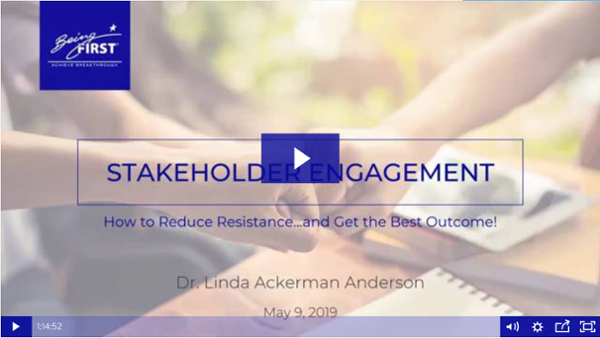Organization transformation, to have staying power all the way through to achievement of proven results, must overtly contribute to the core drivers of business success.
Demand that your change efforts are set up to directly produce the business results called for by your business strategy. Without this connection, you are inadvertently launching changes that do not have relevance and meaning to the very people who must make them happen on the ground. Without this connection, where is the fuel for your stakeholders to undertake the burden of changing?
The Affect of Not Tying your Case for Change to your Business Strategy
 Not tying your case for change to your business strategy sets change efforts up for failure right from the start. It often causes employees to resist change they otherwise would have supported if it was made meaningful to them. It catalyzes employee distrust in leaders and makes employees feel victimized. Let's look at how this occurs.
Not tying your case for change to your business strategy sets change efforts up for failure right from the start. It often causes employees to resist change they otherwise would have supported if it was made meaningful to them. It catalyzes employee distrust in leaders and makes employees feel victimized. Let's look at how this occurs.
Imagine that your senior team decides that the organization needs to implement new Customer Relationship Management (CRM) software. They have determined that this effort will cost a minimum of $20 million dollars over the next two years and will require employees to radically alter the way they work. In making this decision to pursue CRM, imagine that the senior leaders debated for days, weeks, perhaps even months about the merits of this solution. And they chose it for one reason—because they believe that it is required to produce specific business results. They also hope it will ultimately remove costs from the business, enable enhanced product customization, and provide the backbone for the evolution of the organization's business model.
Whatever the desired results, the senior leaders are making what in their best estimate is a sound business decision. They aren't whimsically choosing such mammoth change simply for change's sake.
But it doesn't seem that way to employees. When the CRM initiative is communicated to them, it comes across as a driver of profitability at their expense. Perhaps it feels like one more “flavor of the month” change effort that will simply make their real work more difficult to accomplish. You have likely seen the common employee response to change called “laying low.” The modus operandi of this response is “don't engage; this, too, shall pass.” Employees take this avoidance option when they don't see the logic of the change being pursued and expect it to “blow over” like all other previous unwarranted efforts.
Why Do Employees Fail to See the Logic of Organizational Changes?
Why don't employees see the rationale for a chosen change solution? Because senior leaders often fail to provide the information that would let employees see the reasoning. Leaders often fail to realize that employees need to engage in the same type of internal mental and emotional decision-making process that they did as described in the scenario above. Employees need to wrestle with the factors that generated the decision to pursue CRM. They need the information relevant to them and time to internalize it.
Employees take little at face value. They won't automatically and willingly engage in additional work unless it makes good operational sense. They must see the connection between what the business strategy calls for, what the change will produce and what its impact will be on them. Otherwise, the change activities seem like a burden, a waste of time and counter-productive.
Consequently, a critical success factor in change is overtly making the link between the purpose of the change and the business strategy overt up front and providing employees with the rationale (risk and opportunity) for the change. They must understand how your business strategy is a response to marketplace dynamics, and how your change efforts are attempts to implement your business strategy. In other words, employees must understand change as strategy implementation, just as executives do.
Involve your Employees in the Transformational Change Process
Employee buy-in cannot be achieved through a singular communication event, whether it be a memo or a power point presentation. It requires a thorough plan for developing your case for change and an in-depth communication strategy for making that case known. Remember above, the senior executives likely wrestled with the decision to implement CRM for months. Employees also need their own time to hear the facts, discuss them among peers, entertain the personal implications of the change, offer input, get committed, and finally, to willingly engage in supporting the change.
The answer to the question, “Why change?” should always be “Because we need to succeed at this change to produce the business results called for by our business strategy. We understand the risk of not proceeding or succeeding.” When this answer is as forthcoming from employees as it is from the CEO, then resistance is minimal and maximum employee contribution occurs naturally.
In Summary...
- Make critical marketplace dynamics known to employees in ways they can understand. Do not restrict that information only to managers.
- Make it clear to everyone in the organization how your change initiatives are your efforts to implement your business strategy and ensure business success.
- Make the intended business results of your change efforts known to all. Describe them in compelling, meaningful terms and where possible, quantify these results.
- Provide numerous two-way vehicles for employees to engage in their own thinking and decision-making about the merits of key change initiatives.
- Don't engage in any change effort that your business strategy does not warrant. And stop all those underway that do not produce specific outcomes called for by your business strategy. If you cannot link the change effort to your business strategy, you either need to evolve your strategy or stop the change.
- Build a communication strategy that truly engages employees in understanding the reasons for the change and that overtly links the change to stated business outcomes. (In future newsletters we will discuss the nuts and bolts of such communication strategies.)
- And remember, when employees don't see the logical, sound rationale for change, they often feel victimized by leader's “whimsical” decisions, view leaders as incompetent, and avoid participating in the change. You can avoid all this by simply providing employees with the same type of up-front engagement in the business case for change as the leaders had.
Read the related blog: "Why Change? Great Change Leadership Starts with Your Case for Change"




